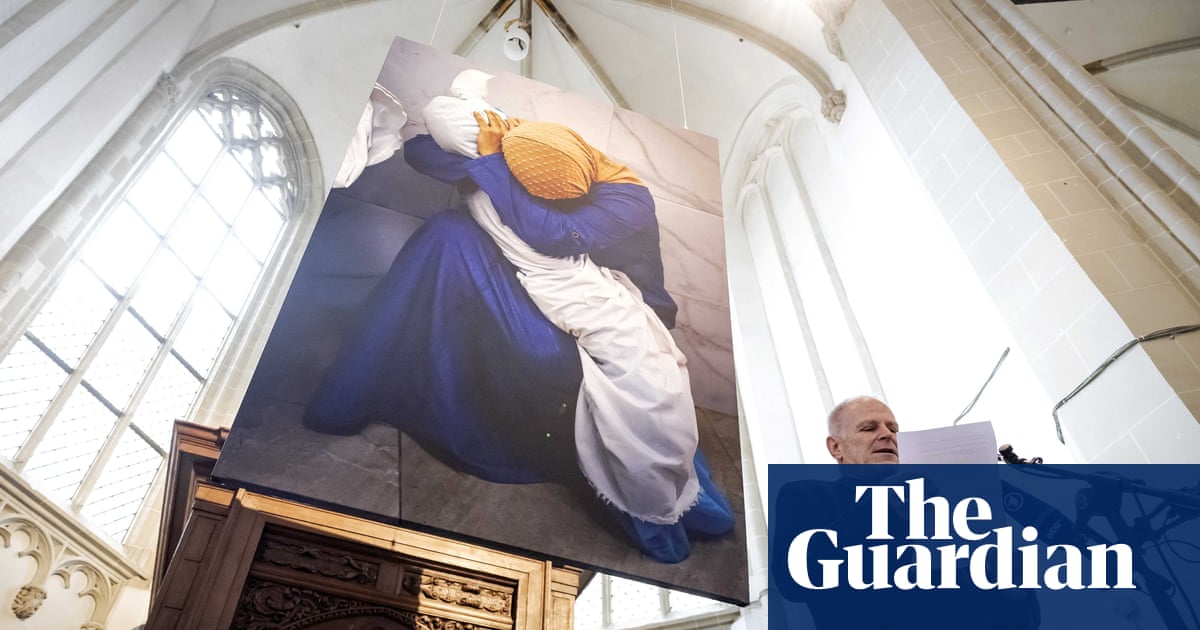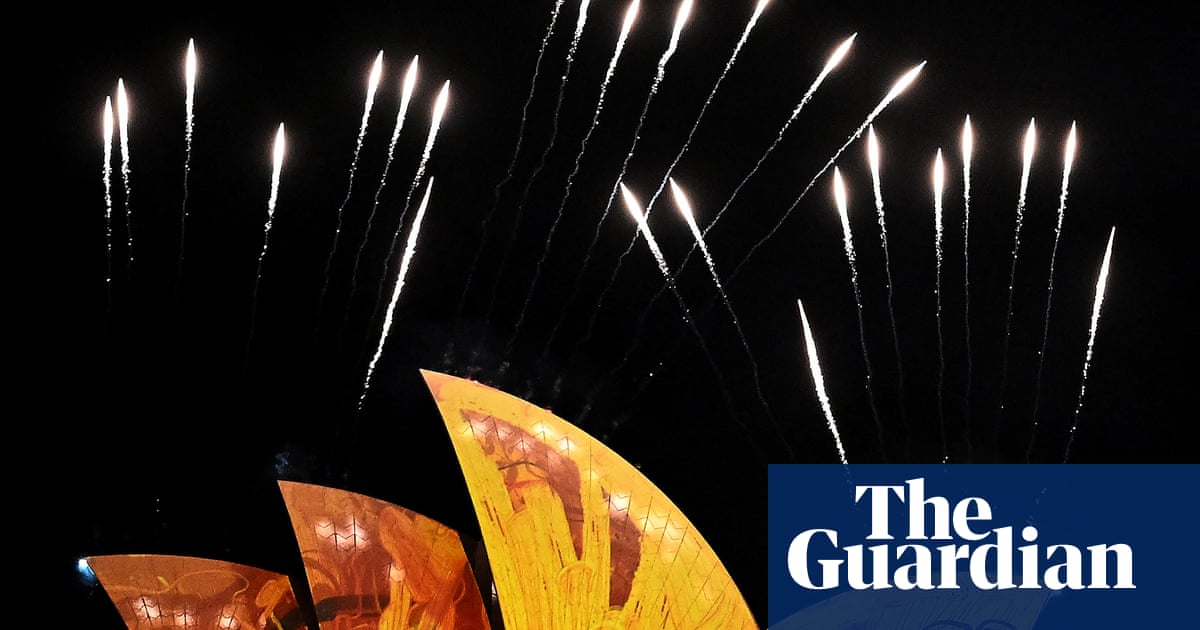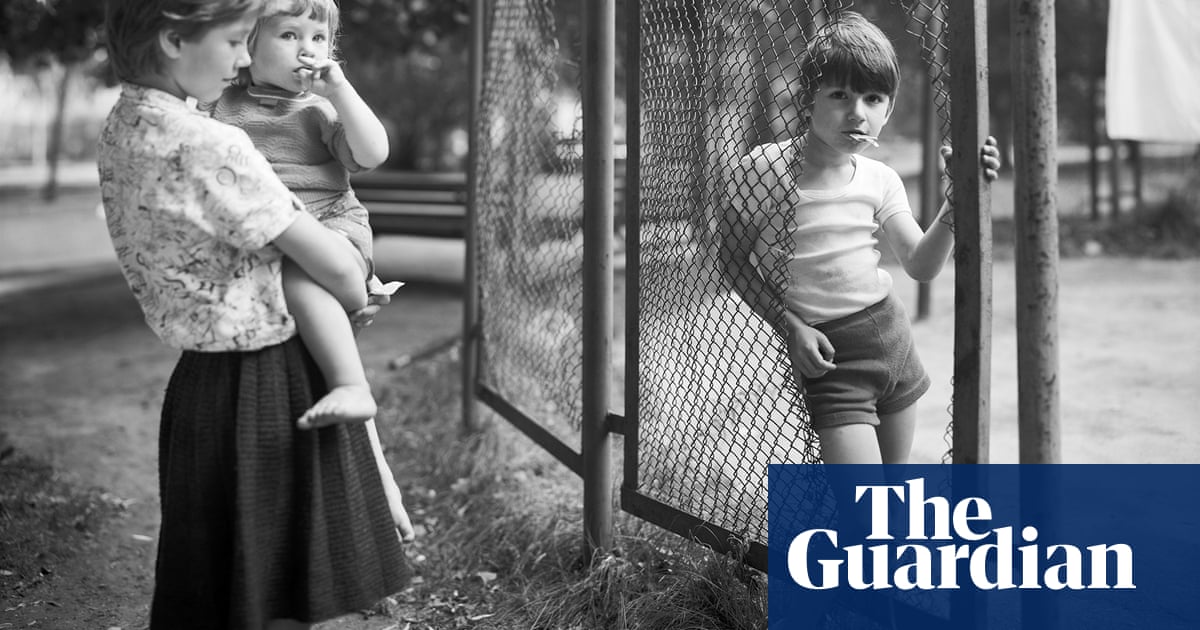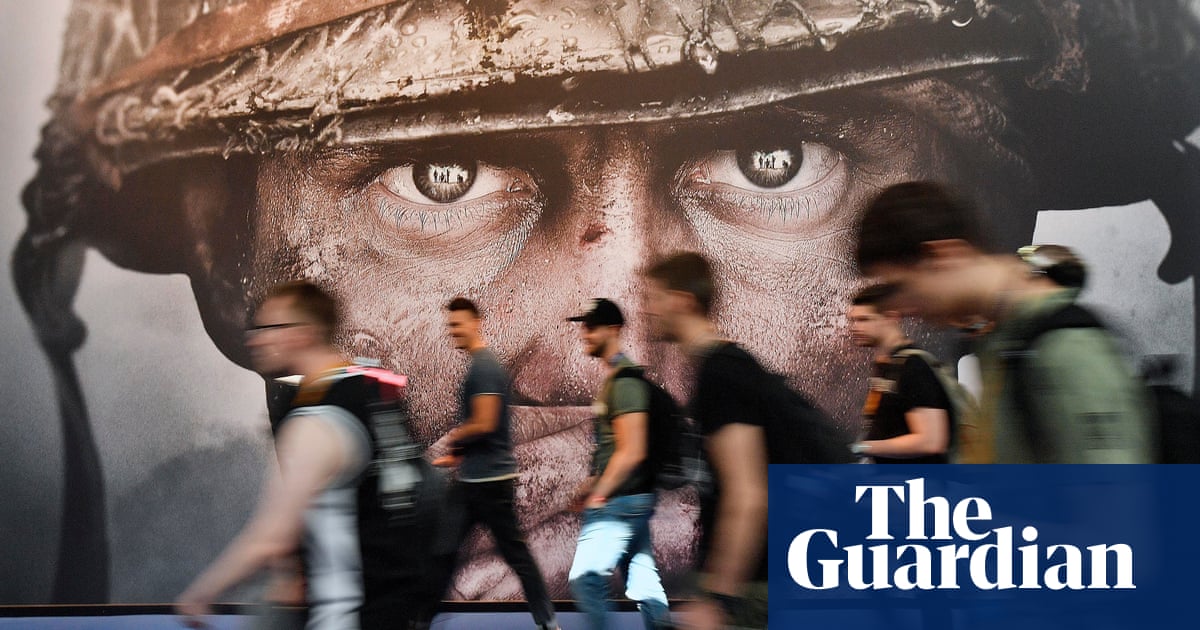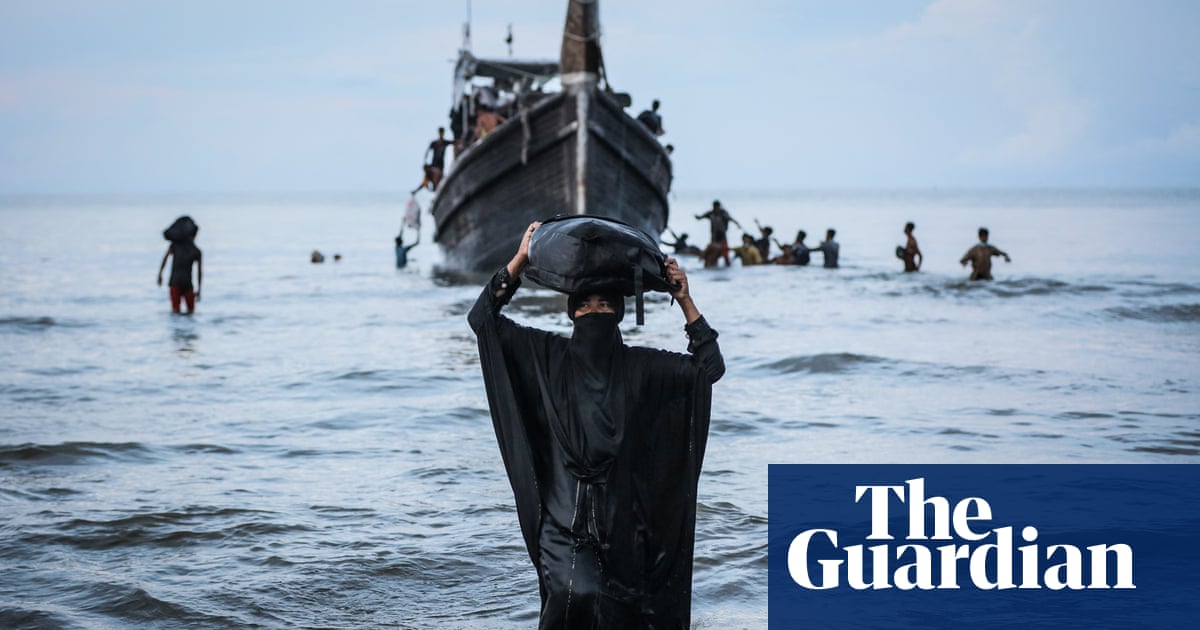
We had been following the clashes in Bolivia, and I was ready to go out to Santa Cruz de la Sierra. The protests had been sparked by the arrest, on 28 December, of the Santa Cruz governor and rightwing opposition leader Luis Fernando Camacho.
On my first night, I didn’t see many people in the streets, but you could hear the fireworks – in Santa Cruz many demonstrators use fireworks and the police respond with teargas and rubber bullets. On my second night, I had got closer to the police officers.
I couldn’t see the protesters because they were on the other side of the street, and I was taking cover by a building. I saw a firework alight on the street, and a group of police officers were in the middle, so I pointed my camera.
One officer had been quite calmly walking towards his car and others had been taking cover behind their shields, but as soon as the firework exploded, they all started to run. Another one landed near my feet, so I got out of there. I had a buzzing in my ear for about a week.
Dnipro, Ukraine, 14 January
Rescuers try to free survivors from the rubble of a building hit by Russian forces Wojciech Grzedzinski/the Washington Post via Getty Images
The rocket hit one of the buildings in the late afternoon, and was probably aimed at the nearby power plant. Part of the building collapsed and more than 40 people died that day. What particularly bothers me is that a lot of people that were killed were already refugees from the fighting areas, so they were seeking a haven in Dnipro.
What really hit me was how many volunteers there were, coming to this strike zone, offering to help, alongside the professional rescuers. There was a huge group of people helping to clear the site to make it available to trucks and ambulances. People were bringing hot tea. It was a community; people were helping each other.
They were extinguishing fires and looking for survivors for almost two days. Once in a while there was silence, in case they could hear people under the rubble. There were search dogs, and everything was super-organised and professional.
This is the only thing I can do: take pictures and send them to the media to show what is going on in Ukraine. For me, it’s always a difficult moral situation because sometimes I feel I’m waiting like a vulture. Because I’d been living in Dnipro, it was my temporary home, it’s a city I have friends in, so it was personal for me.
Lützerath, Germany, 14 January
Protesters fight with riot police during an eviction Nico Knoll
For more than two years, protesters occupied the abandoned village of Lützerath, in western Germany, to try to prevent an energy company extracting coal from beneath it. I had been a few times during that period, but in January there was a plan to evict the protesters. It was intense, because the eviction unfolded fairly fast over several days. This photograph was taken near the end of the eviction.
A big demonstration had been planned for that day. About 25,000 people had gathered and were marching towards the village, to support the protesters who had occupied it. By this point, Lützerath was surrounded by police. As the protesters tried to get past them and into the village, the police responded with violence.
It went on for the whole day. I could see from where I was, standing on a mound of dirt, that it was like a frontline. I was so shocked by the violence of the police that I thought I needed to be completely in there to capture the feeling of pure chaos.
The tactic the riot police used involved making a long row and screaming at the protesters to get back. If they didn’t, the police would raise their batons, scream again, then run into the crowd, punching people, and then retreat again. I took this photograph at one of those moments. People were falling over and getting hurt.
That morning, it felt like a huge empowering moment, because so many people had come to protest. But then, seeing this violence and realising the police and the state were willing to do anything to defend capitalist interests – ones that would add to the climate catastrophe – was so shocking.
Sony world photography awards, 14 April
Winning entry Boris Eldagsen
In 2022, I was experimenting with artificial intelligence to see if I could use it for a project based around the second world war and long-term trauma, which is why this image has that 1940s aesthetic. It took a couple of days to create, using the AI image-generator DALL-E 2, and about 20 “prompts” until I was happy with it. I started with the faces of two women, and it developed from there.
I chose to enter The Electrician at the Sony World Photography awards as a test. When I was informed that I had won an award, I told them how it was produced. If they didn’t disqualify me, then I wanted some kind of discussion about the relationship between AI and photography, but it seemed they just preferred to keep it under the radar. [The World Photography Organisation said that it would no longer engage with Eldgasen because he had misled it.]
My rejection of the award became global news, and showed it was important to raise questions about AI and its consequences. The reaction from the photographic community was 95% positive, because I had made the issue transparent.
I’m concerned that images can be generated and used for disinformation. We need a discussion, and a system that factchecks and allows us to maintain trust. But as an artist, I love the new technology and its possibilities.
Florida, US, 13 May
Vanilla the chimp sees the sky for the first time savethechimps.org
Vanilla spent her early years in a medical research lab in New York in the 90s, then was sent to a California refuge where she was kept in a concrete-floored enclosure for more than 20 years. In July 2022, she was taken in by a sanctuary run by Save the Chimps in Florida. “When she first arrived, I’ll never forget she wouldn’t come down from the upper perches of the enclosure because she had never been on grass before,” says Dan Mathews, from the organisation. “It took her a few weeks to even acclimatise to walking on grass.”
Over many months, she was assessed by primatologists and experts to work out which of the 12 three-acre islands, and their chimp communities, Vanilla would best thrive in. “After a few introductions, it became clear that she had a bond with Dwight, who was the alpha male on one of the islands. She is a very small chimp, but she has a big personality.”
She was finally introduced to the island in May, with this moment captured by one of the Save the Chimps staff. “She was really hesitant because she’d never seen the open air before. The chimp behind her, urging her along, is Dwight.” Vanilla had never been free to roam before, and had “never seen the open sky without bars in front of her face. There was definitely a collective gasp of joy, to see her feel that first taste of freedom.”
Fiji, 22 May
Teens pose on a seesaw underwater Nick Brandt
This is one of a series, photographed in April and May in Fiji, dealing with the impacts of rising sea levels as a result of the climate crisis. I always like to leave the viewer to interpret the work, but for me it’s about a sense of loss for these children’s future. What should be the innocence of childhood is replaced by anxiety.
We built the seesaw, which was weighted down, and Onnie and Keanan had concealed weights in their clothing. I wanted them to look relaxed and for the scene to look as everyday as possible, with the sole obvious exception that it’s in the ocean. They’d had scuba diving training, and a safety diver was just out of shot with a regulator to hand so they could take a breath when they needed to.
The seesaw is a useful symbol we all recognise from a classic playground, and this photograph epitomises the title of the series, Sink/Rise. Do we resign ourselves to our fate, to allow climate breakdown to overwhelm us, and for countless many to see their homes and land eventually sink under the rising waters? Or do we rise up and do our damnedest to minimise the damage?
Manchester, UK, 12 June
Jack Grealish celebrates Manchester City’s treble Lexy Ilsley
The parade in Manchester happened after City had completed the treble by beating Inter Milan in the Champions League final. The whole club was on a high and you could feel the excitement in Manchester. As far as you could see, the streets were lined with City fans – it really was spectacular.
I was on a bus with the manager, Pep Guardiola, and his staff, and I wanted to see what was happening on the bus in front, which had the players on. Jack Grealish and I caught one another’s eye and from nowhere he struck this pose and I caught it.
It sums up how everyone across the club was feeling, as if he’s saying: “Look what we’ve done!” It’s a historic achievement, but it’s not just about Jack. You can see other players, including John Stones and Bernardo Silva, and the fans – it’s a real snapshot of the whole football club at that moment. Jack being the subject helps because he is such a likable person and player, and the rain adds another dimension – it’s very Manchester.
Glastonbury, Somerset, UK, 25 June
Fans watch as Elton John performs Leon Neal/Getty Images
Everyone was saying that it was going to be Elton John’s last ever UK performance, though I think you never know with musicians. Throughout the day, I saw people walking around wearing Elton costumes from different eras. When it came to the show, I made my way out into the crowd and found a decent spot. Shortly before it started, these people turned up in front of me, wearing identical Dodger Stadium costumes, and I thought I wouldn’t get a clean shot of Elton. Then I realised it was actually going to make the picture to get a different angle on the whole thing. I took this quite early in the set, while it was still light, because as it got darker, I was aware that you weren’t going to be able to see their costumes.
It was certainly a party atmosphere and a friendly crowd – sometimes when you are working in the crowd, rather than at the front, people can get a bit unhappy with you being there, but there was a lot of positivity that day. I can’t imagine Elton is going to be sitting at home and never wanting to feel that feeling again, playing in front of so many people, so it wouldn’t surprise me if he was back at some point in the future. But it certainly had the feeling that this was Elton’s last celebratory show.
Nairobi, Kenya, 19 July
A man sits in front of a burning car Luis Tato/AFP
There have been protests in Kenya for much of this year, driven by several factors – political and economic, particularly the cost of living. The opposition party has a lot of support, and it often calls for people to take to the streets. For a while, protests were happening weekly.
This man was in Kibera, a huge informal settlement in Nairobi, where the opposition party has a lot of support. People were protesting heavily that day, burning tyres and cars, creating barricades and fighting with the police. At some point, later in the day, I had reached the area where they were actively rioting and I saw this protester, sitting in front of a burning car. He was repeating anti-government chants, and I found it powerful. I think it defines the frustration of certain sectors of the society in Kenya.
Many of the protesters have been hit particularly hard by the economic problems. On the other side of the picture, there was a huge police deployment, and police would fight with teargas and rubber bullets, so the situation was tense. The protests were quite violent that day, and there was a lot of destruction. But I was fascinated by the integrity and confidence that this guy had, demanding what he thinks is right.
Maui, Hawaii, 8 August
Wildfires burn over the town of Lahaina Gonzalo Marroquin
My wife and I were on holiday in Maui with our eight-month-old son. It was my first time in Hawaii, and it was beautiful. One night, about a week in, I could hear really intense winds. There had been wildfire warnings, and the next day the power went out.
Our son was out of nappies, so we drove to Lahaina, the nearby town, and it was chaotic. There were police and lines of cars. You could feel something bad was brewing. We heard a loud crack – one of the electricity poles had broken and it fell in the road, and we could see sparks. We made it to the supermarket, grabbed some nappies and got out of there.
They had closed the main road, and we were one of the last cars to make it out of Lahaina because, a few minutes later, the fire started. We didn’t know at this point, because back at our hotel, our mobile phone coverage and internet were gone, and there was still no power.
But we could see a massive cloud, and we were told the fire had hit Lahaina. This photograph was taken that night, probably shortly before midnight. The fire was still burning and was so big that you could see the reflection of it in the smoke, even though it was several miles away. You could hear it.
I was shooting upwards, on a long exposure with a tripod, trying to get some stars and the colour of the fire. It created huge destruction and loss, and killed at least 100 people. If we had got stuck in Lahaina, I don’t know if we would be having this conversation. There were so many people who got stuck right after we left.
California, US, 21 August
Trapped care home residents are saved by rescue workers Alex Welsh/New York Times/Redux/eyevine
This block in Cathedral City, in southern California, was hit particularly hard by Tropical Storm Hilary. When I arrived at the scene in the morning, I talked with the fire crew outside who said a residential care facility had been flooded with mud. There were also several gas leaks, and elderly people were trapped inside, chest-deep in mud.
I spent the day working, and was filing images from my car when I looked up and saw this bulldozer come through the mud, its bucket raised with people inside. I realised this was how they were getting the residents out, so I ran over. It was surreal – I had never seen a rescue operation like it.
There were three spaces in the bucket of the bulldozer, so three people could be taken at a time, and they did it over and over until more than a dozen residents were evacuated to safety and medical attention. Every resident had a rescue worker sitting behind, holding them.
As the mouth of this bulldozer was lowered, I saw these two women were holding hands. It was a brief, but powerful, moment, where they had been through a horrendous experience and were comforting each other. I could feel the emotion as I was shooting.
Atlanta, US, 24 August
Donald Trump scowls in his mugshot Fulton County Sheriff’s Office/ZUMA Press Wire/Shutterstock
Marking the first ever mugshot of a US president, this image of the former president Donald Trump was taken at Fulton county jail in Atlanta, Georgia. He had turned himself in to face charges of alleged interference in Georgia in the 2020 election. While several of his co-conspirators are smiling in their booking photos, Trump is glowering and defiant. It was no accident – Trump posted the image on X (formerly Twitter) that evening with the words “NEVER SURRENDER”.
The photograph is as divisive as he is. For his detractors, it is historic and shaming, perhaps the biggest sign of how low US politics has sunk. For his supporters, many will see it as a man fighting the elites, a victim of a liberal conspiracy.
It was also a gift to his campaign. Never one to miss an opportunity to monetise anything, the former president’s campaign team had already been marketing T-shirts with a pretend mugshot on. Now they had the real thing.
Nevada, US, 1 September
A double rainbow at Burning Man Sinna Nasseri shot for Bon Appetit
I’d been at Burning Man for about three days before it started raining. I went to bed really late after staying up and partying, and then when I woke, everything was flooded. Around sunset, I heard people screaming “Rainbow!” and ran out with no shoes on, trying to find objects to put in the foreground with the rainbow in the background. I saw this bohemian-style man standing on the top of his truck and taking it all in.
The alkaline salt flats took in all the water. Everyone was stuck there for days, even weeks. You can see these divots in the mud in the foreground from people trying to walk through – it would suck you in to the earth, and it was really hard to even take a step. That’s why I wanted to go low, to show what we were facing.
I was hoping to leave on Friday, which is when this picture was taken, but I left on Sunday. A lot of people were stuck for longer than that. The atmosphere was actually really positive – everyone was trying to have a good time, sharing food as usual. It wasn’t like some kind of humanitarian situation. I went out that night and everyone was dancing in the mud, the drugs were still flying and the DJs were still playing.
US-Mexico border, 28 September
Migrants crossing the Rio Grande John Moore/Getty Images
Eagle Pass is a small Texas town located on the American side of the US-Mexico border, which is where many immigrants cross. Here, the river is about 100m wide and waist deep in some areas. It’s tough to watch as people struggle in the water, especially carrying children, and many of them don’t swim. The number of deaths as people cross this river is not small; it happens frequently.
Most of the people I photograph are from Venezuela, and have travelled through the infamous Darién Gap to Central America and up towards the US. When Americans think about immigration, they often think about the border, but for these people that is just the last step of a much longer and very difficult journey.
I made this picture with a drone. The US authorities had begun limiting media access to the riverbank. It captures a group of Venezuelans struggling through the undergrowth below the water’s surface. Although it’s shallow in this area, the current is strong and people can get tangled and often fall. They had to wait on the US side for a considerable time before US border officials allowed them through the razor wire fence to enter and be processed as asylum seekers. They are not “sneaking” into the US, they aren’t running away from the border officials – they want to present their case.
Thousands of people can cross this part of the border every day, and there was a large surge of them crossing in September. It’s very easy to get caught up in the numbers but the truth is, all these are individual people with difficult stories of their own.
Rehovot, Israel, 13 October
Israelis take cover as a siren warns of incoming rockets Dor Kedmi/AP
I was on my way to a military base where my younger sister is serving, to bring her clothes and food. After the terrible massacre on 7 October, fear and anxiety in Israel were very present. A sense of safety was no longer guaranteed.
I had my son with me, and as we approached the intersection near the base, we heard the warning siren. The road was packed with cars and it was chaotic. We got out, jumped over the safety rail by the side of the road and lay on the ground, in a ditch under the highway. While trying to protect my son, I noticed a father desperately shielding his children. Within seconds, loud explosions began to be heard. That’s when I picked up the camera and took this frame.
Above us, we could hear and witness the interception of missiles, and we feared falling shrapnel. After about 10 minutes, we swiftly made our way back home. At that moment, and also in the days leading up to that event, I was afraid for the fate of the country, and for my family.
Khan Younis, Gaza, 17 October
A woman embraces the body of her niece killed in Israeli strikes Mohammed Salem/Reuters
I had gone to the Nasser hospital in Khan Younis, in southern Gaza, to document what was happening at the morgue as people who had been killed in Israeli strikes were brought in. I had seen this woman earlier, running, crying, and searching for her family members. When I saw her again, she was holding the wrapped body of a child, overcome with grief and pain. Much later, we found out this was her five-year-old niece, Saly.
The scene around me was full of people screaming, crying and grieving. The floor was stained with a lot of blood. I felt stunned as people were trying to identify the bodies of their relatives. My family and children came to mind, and I felt that we could be in the same situation, as we all are living here and facing this risk. My children and I are surrounded by danger. I will never forget this photograph. It had a big impact on me, and when I left the hospital I could not control my emotions.
I was motivated to take the picture because I thought it might reach all decision-makers and the world, and I hoped it would be a reason for stopping the killing and destruction in Gaza.
New York, US, 29 October
Visitors attend the Friends Experience Jeenah Moon/New York Times/Redux/eyevine
That Saturday night, I heard the news that Matthew Perry had died and the next day I got a phone call from my editor asking me to go down to the Friends Experience, an attraction for fans of the show. It was a rainy day, and I didn’t expect so many people, but it was very crowded.
Before you go on the tour, there’s a waiting area with a big screen showing clips of all six actors. I was standing behind the crowd because I didn’t want to block the screen, but I liked seeing people watching when clips of Perry came on.
You could see they were touched. We know he had problems, but there was something nice about seeing him in those clips looking younger and happier, and making people laugh.
I’ve been watching Friends since I was at high school, and I still can’t believe he’s gone. It’s sad for me, too.
London, UK, 7 November
Anti-monarchy protesters outside the Palace of Westminster Gareth Fuller/PA
The anti-monarchy protesters were on the corner of Parliament Square, and my brief was to cover the demonstration. There were about 50 to 100 people shouting slogans, but they were not boisterous and they weren’t trying to climb over the rails. They were pretty vocal as the procession came through.
My aim was to try to get something of King Charles and the queen with the protesters, to try to sum up that aspect. When the carriage came past, I was tracking it through the camera, and shooting at the same time. Although I had planned where I was going to stand, and how I wanted to frame it, you don’t quite know what you’ve got until you look back through the camera. I managed to get the sign bang in the middle of the window. There’s a bit of luck involved.
When Elizabeth II was around, we didn’t really see these kinds of protests at royal events. Charles is a new king, and the monarchy – and the world – is changing. People have got a point of view and a right to that point of view. He’s an intelligent man, I guess he’ll accept it.
Ulee Madon, Indonesia, 16 November
A Rohingya refugee walks to the beach Amanda Jufrian/AFP
Initially, this group of Rohingya refugees, fleeing persecution in Myanmar, tried to land at a different beach, but the local people there refused them. They continued some way along the coast of North Aceh, and anchored off Ulee Madon beach.
This marked the first refugee boat landing in Ulee Madon. They were permitted to come ashore to eat and drink, but the local community didn’t want to accept them, and only gave them permission to land temporarily.
This woman was coming ashore, carrying her belongings. There were about 200 people, including children, and they had been at sea for about 20 days or more. Their condition was dire – they were exhausted, hungry, and some were sick.
They were allowed to land, provided with food, drink and supplies, including donated clothes, but after about four hours, they were ordered to line up and to walk back through the sea to their boat.
When I captured images of the refugees at that moment, I felt a deep sadness witnessing them having to return to the boat, and continue the very dangerous journey.
Jalandhar, India, 19 November
Hindu devotees offer prayers on Chhath Puja Shammi Mehra/AFP
At the Hindu festival of Chhath Puja, people offer prayers to the sun god, Surya, to show thanks and gratitude. It involves fasting, bathing and making offerings. The festival, which is particularly important across northern and eastern India, lasts for four days, and on the third day devotees go to a nearby body of water.
This year, Chhath Puja fell in mid-November and this photograph was taken in Jalandhar, in Punjab. Thousands of people were there. Devotees make their way into the canal to pray and make offerings of fruit and special dishes as the sun sets.
I go every year, and usually stand by the side of the canal to photograph the devotees in the water, but this time I decided to stand in the middle of the canal to get a good shot. I spent about 20 minutes there, and since it is winter, it was cold.
The people in the water are mostly in quiet, contemplative prayer, but along the canal and road there is noisy celebration, with music and firecrackers. When the sun sets, the devotees join them, and there is dancing along the side of the canal all night. They pray again in the morning to the rising sun.








